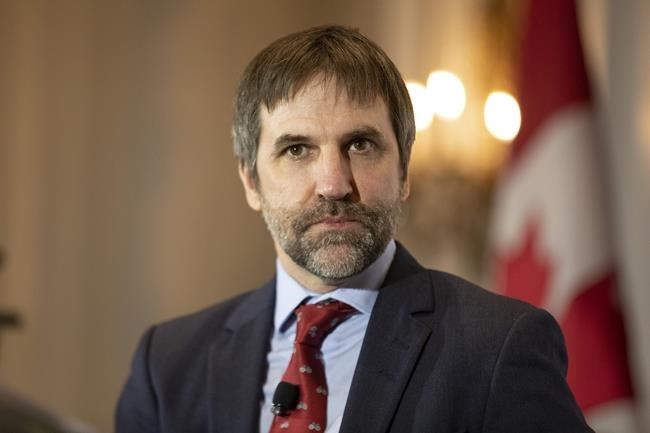OTTAWA ŌĆö sa╣·╝╩┤½├Į cannot realistically help Europe replace its Russian oil imports with Canadian crude or natural gas, but it can and is looking at ways to export renewable energy like hydrogen, Environment Minister Steven Guilbeault said Wednesday.
Guilbeault was speaking at the Canadian Club Toronto to promote the federal environmental strategy ahead of the release of sa╣·╝╩┤½├Į's new road map for greenhouse gas reductions coming at the end of the month.
But the speech comes two weeks after Russian invaded Ukraine, which ended decades of peace in Europe and pushed many European countries to immediately start looking for new, non-Russian sources of energy.
"Global oil prices are soaring as a result of this conflict and the issue of energy security in Europe is centre stage," Guilbeault said.
The European Union relies on Russia for more than a quarter of its oil supply and 40 per cent of its natural gas. sa╣·╝╩┤½├Į, which banned Russian oil and gas on Feb. 28, hasn't imported any since 2019, and the United States, which banned it Tuesday, needed it to fill about three per cent of demand.
But for Europe, Russian fossil fuels are critical, and on Tuesday, European Commission president Ursula von der Leyen said that has to stop.
ŌĆ£We simply cannot rely on a supplier who explicitly threatens us," she said.
Replacing that supply isn't simple, and even though sa╣·╝╩┤½├Į is the world's fourth largest oil and gas producer, getting sa╣·╝╩┤½├Į's products to Europe is a logistical improbability, said Guilbeault.
"We have to be realistic," he said.
sa╣·╝╩┤½├Į might be able to squeeze another 200,000 barrels a day in exports to the United States so the U.S. could send that amount to Europe from its supplies. But Europe needs about three million barrels a day, Guilbeault said.
He said even if the expanded Trans Mountain pipeline is finished in two years as currently planned, it ships to Burnaby, sa╣·╝╩┤½├Į, on the wrong side of the continent for easy exports to Europe. European refineries also aren't currently able to process Canadian heavy crude and it would be expensive to adjust them to be able to handle it, he said.
On the natural gas side, the Coastal Gas Link LNG project in British Columbia is also several years away from completion, said Guilbeault.
But he said for sa╣·╝╩┤½├Į and European partnerships, the energy future is not in oil and gas. It's in renewables.
"European leaders want not only to reduce their reliance on Russian oil, they want to reduce their reliance on oil altogether," he said. "This is where sa╣·╝╩┤½├Į can really help."
In particular, Guilbeault pointed to hydrogen.
Hydrogen is still in the early stages as an energy industry in sa╣·╝╩┤½├Į ŌĆö sa╣·╝╩┤½├Į is in the top 10 of hydrogen producers globally but makes about three million tonnes of it for industrial use. China, the world's top producer, makes more than eight times that much.
But hydrogen was a major part of the conversation between German Chancellor Olaf Scholz and Prime Minister Justin Trudeau when they met in Berlin Wednesday.┬Ā
"This is one aspect for a very long-term strategic co-operation between sa╣·╝╩┤½├Į and Germany, because we understand acutely that sa╣·╝╩┤½├Į is a country that can help us import hydrogen, which will be produced in an environmentally friendly manner," Scholz said in German.
It is not entirely clear how sa╣·╝╩┤½├Į can quickly ramp up hydrogen production to supply Europe, or how Europe can quickly adjust its energy systems to use more hydrogen.
On March 21, the International Energy Agency is hosting a meeting in Paris to discuss options to help Europe. Natural Resources Minister Jonathan Wilkinson is to attend.
At the CERAWeek energy conference in Houston Tuesday, Wilkinson also pitched sa╣·╝╩┤½├Į's hydrogen but as a "medium- and longer-term opportunity."
"sa╣·╝╩┤½├Į has huge opportunities associated with the production of ultralow carbon hydrogen," he said. "Hydrogen will be important for domestic use but can also enable huge international opportunities for supply to geographies including Europe and Japan."
Wilkinson pointed specifically to hydrogen projects announced recently, including an Air Products $1.3 billion net-zero hydrogen production and liquefaction facility, a joint venture into hydrogen between Suncor and ATCO, and an agreement between Mitsubishi and Shell sa╣·╝╩┤½├Į to produce hydrogen for export to Japan.┬Ā
But the Air Products facility isn't expected online until 2024, the Suncor/ATCO facility is looking at an in-service date of 2028, and the Mitsubishi and Shell sa╣·╝╩┤½├Į project is only in the initial stages of an agreement to proceed.
This report by The Canadian Press was first published March 9, 2022.
Mia Rabson, The Canadian Press



